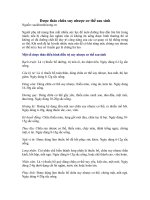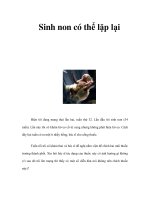The Reproductive System docx
Bạn đang xem bản rút gọn của tài liệu. Xem và tải ngay bản đầy đủ của tài liệu tại đây (3.42 MB, 43 trang )
1
The Reproductive System
Sexual
Reproduction
Cellular
Reproduction
Figure 28.5
Fertilization
requires haploid
gametes
Growth and
development of all
somatic cells
The simplest form of reproduction is cellular reproduction. Single celled
organisms can use mitosis to reproduce the entire organism and increase
the specie's numbers, but multicellular, organisms including man, use mitotic
cell division to grow, repair, and replace somatic cells and tissues in the
body. Mitosis is employed from the first division of the fertilized egg (zygote)
to the development and maturation of all somatic cells and tissues. The cells
it produces are all genetically identical, but they differentiate to become
varied in structure and function and employ only the genes necessary for
those specific structures and functions. If organisms only reproduced by
mitosis, i.e. asexually, they would all be genetically identical, and vulnerable
to any disease that came along to which the population was not resistant.
Sexual reproduction has evolved to provide genetic variability within the
population. Even single celled organisms employ sex to maintain their
genetic variability. And for complex organisms such as humans, sexual
reproduction is the only form, future cloning notwithstanding! Sexual
reproduction employs not a splitting of cells as in mitosis, but a union of cells
from two different organisms (usually) in a process called fertilization. In
order for this to occur gametes (sex cells, i.e. sperm and eggs) must be
produced which have half the chromosome number as the somatic cells, so
that when fertilization brings two such cells together the normal chromosome
number is produced in the zygote (fertilized egg). We call this number
haploid and the number of chromosomes in the somatic cells diploid.
9:17 pm, Nov 18, 2006
Real Media File for
Male Reproductive
System
2
Cellular Reproduction
Mitosis – exact
duplication of genetic
material to produce
daughter cells which are
genetically identical to
parent cell.
Produces all somatic cells
of the body; all cells
except gametes (sperm and
eggs).
Diploid Cell
Mitosis produces all the somatic cells of the body (non-gametes), and they
are all genetically identical.
3
Meiosis
Meiosis – division which
reduces the number of
chromosomes to produce
haploid gametes.
•Two division phases.
•Homologous pairs separate.
•Crossover magnifies the
genetic variability.
Diploid Cell
Meiosis I
Meiosis II
Homolgous
pairs separate
producing
haploid cells.
The division process which produces haploid cells is called meiosis. In fact,
not only must the number be half in the gametes, it must be a specific half,
namely one of each homologous pair of chromosomes. Each pair consists
of chromosomes having the same genetic loci or genetic characteristics
represented. If proper separation of these homologs fails to occur (called
non-disjunction), the resulting zygote can have too many or too few
chromosomes. For example, Down's Syndrome results from three of
chromosome number 21. Meiosis occurs in two division phases. In the first
division the homologs separate producing two haploid cells. Since there are
23 homologs with a choice of 2 for each, the number of different possible
combinations of these in the haploid cells is 2
23
or 8 million. In practice there
are many times this because the homologs cross over and exchange parts
(synapsis) in prophase of meiosis I, changing the assortment of the genes.
In meiosis II, the chromatids of each chromosome separate in a process
reminiscent of mitosis. The potential number of gametes is four for each
meiosis, but that varies in practice as seen below.
4
Spermatogenesis
Seminiferous tubules
of testis
Spermatogonia
Mature sperm in epididymis
Maturation called
spermiogenesis
Sertoli cell
nucleus
Sustentacular
(Sertoli) cells –
stimulate
spermatogenesis
and manage the
sperm’s
environment.
1
o
spermatocyte
2
o
spermatocyte
Spermatids
Meiosis I
Meiosis II
The process of sperm formation occurs in the seminiferous tubules (See
Figure 28.3). A man is born with stem cells or spermatogonia which have
the potential to produce sperm. These cells divide continuously throughout
the man's life producing more stem cells and, simultaneously, cells which
undergo spermatogenesis. Spermatogenesis consists of two parts: meiosis
which produces haploid pre-spermatozoa called spermatids, and
spermiogenesis which is the maturation of these spermatids to produce
mature sperm. Sustentacular cells manage the process in the seminiferous
tubules, maintaining the environment of the spermatocytes and secreting
ABP (Androgen Binding Protein) that, in combination with testosterone,
stimulates the completion of spermatogenesis. Spermiogenesis begins in the
seminiferous tubules, but is usually completed in the epididymis .
5
:
Figure 28.19
Oogenesis
Oogonium
:
1
o
oocyte
:
2
o
oocyte
:
Meiosis I
Meiosis II
Primordial
follicles
Developing
follicles
Ovulation
2
o
oocyte
2
o
oocyte
Meiosis II only
occurs if
sperm
penetrates
oocyte.
Meiosis II only
occurs if
sperm
penetrates
oocyte.
Polar body = non-
functional cell – all
cytoplasm goes to
oocyte.
1
o
oocyte arrested in
prophase of I
At birth
:
The oogonia have already matured before birth and women are born with a
limited number of primary oocytes which have already begun, and are
suspended in, prophase of the first meiotic division. Each month a small
number of these primary oocytes continue meiosis I, usually from alternating
ovaries, and usually only one becomes a secondary oocyte. (Fertility drugs
are FSH derivatives and stimulate many follicles, which increases the
probability that some will develop into secondary oocytes to be fertilized) It is
the secondary oocyte which is ovulated. Surrounding each early primary
oocyte is a primordial follicle. These follicles develop along with the
oocytes, first becoming primary follicles and continuing as growing or
secondary follicles, and ultimately becoming a mature (a.k.a. Graafian or
vesicular) follicle which contains the secondary oocyte which is ovulated.
6
Spermatogenesis vs. Oogenesis
• Four gametes formed per
meiotic division
• Unlimited number of
gametes may be formed
throughout the man’s life
• Only one functional
gamete per meiotic
division
• Limited to those
primary oocytes present
at birth
• Second division only
occurs if fertilization
occurs.
:
7
Brain-testicular
Axis
testosterone
inhibin
FSH
ICSH
1) Hypothalamus monitors L
hormone levels.
2) FSH and ICSH are released.
3) FSH stimulates release of ABP
(androgen binding protein).
4) ICSH causes release of
testosterone -ABP binds
testosterone to stimulate
spermatogenesis.
5) Negative feedback by
testosterone
and inhibin
suppresses gonadotropins.
Sustentacular cell
Spermatogenesis is controlled by the gonadotropins of the anterior pituitary,
which in turn are controlled by the hypothalamus. ICSH (Interstitial Cell
Stimulating Hormone, a.k.a. LH) stimulates the interstitial cells to produce
testosterone and other androgens. FSH stimulates the Sustentacular
(Sertoli) Cells to produce a substance called Androgen Binding Protein
(ABP) which, as its names suggests, binds to the androgen testosterone.
The testosterone-ABP combination stimulates spermatogenesis. Feedback
to the hypothalamus-pituitary controls the process. Testosterone in the blood
feeds back to suppress ICSH release. This modulates testosterone levels,
keeping them within the normal range. Testosterone is important for other
processes such as the normal function of the seminal vesicles and prostate,
as well as other masculinizing effects. A hormone product of the
Sustentacular Cells called inhibin acts to suppress the secretion of FSH by
the adenohypophysis. Testosterone and inhibin act independently in
suppressing ICSH and FSH, but both suppress GnRH from the
hypothalamus. In ways not completely understood FSH is also suppressed
when sperm are not ejaculated and build up in the epididymis. Under these
conditions spermatogenesis slows to a crawl. Conversely, if sperm are
ejaculated often and therefore don't build up FSH is not suppressed and
spermatogenesis is encouraged.
8
Control of Spermatogenesis
Hypothalamus
Adenohypophysis
FSH ICSH
Sustentacular cells Interstitial cells
ABP Testosterone
Spermatogenesis
Inhibin
-f.b.
-f.b.
Regulates
rate of sperm
formation.
Regulates
rate of sperm
formation.
Regulates
testosterone
level.
Regulates
testosterone
level.
Under normal circumstances the level of testosterone feeds back to
regulate ICSH release and therefore keep testoterone levels within the
normal range. Likewise, inhibin regulates FSH release and
spermatogenesis. But excessive levels of testosterone, e.g. when
abused, will suppress GnRH and both FSH and ICSH release and
therefore the body's own testosterone production and
spermatogenesis fails.
9
The Testes
Tunica vaginalis
Tunica albuginea
Seminiferous tubules
septum
Rete testes
Head of Epididymis
Cauda epididymis
Ductus (vas)
deferens
Spermatic
cord
Testicular artery
Testicular
veins
Testicles are suspended in a skin-and-muscular sac known as the scrotum
into which the testes descend before birth. (See Figures 28.2 and 28.3) The
scrotum is lined with a thick tunica vaginalis and each testis is covered by a
whitish tunica albuginea which forms septa which divide the testis into
lobes. The process of sperm formation occurs in the seminiferous tubules.
From the seminiferous tubules the sperm migrate through the rete testes to
the highly coiled epididymis (Figure 28.3). The epididymis actually stretches
to 4 to 6 m. and consists of a head, a body, and a tail (the cauda
epididymis), which wraps around the testis. The epididymis leads to the vas
(ductus) deferens which carries sperm to the urethra. Sperm mature during
their passage through the epididymis acquiring motility and the ability to
fertilize an oocyte.
10
Sustentacular cell
Outer epithelium
Spermatogonia
Spermatocytes
Spermatids
Cells of the Seminiferous Tubule
11
Spermatocyte
Spermatid
Sertoli
(sustentacular) cell
Sustentacular (Sertoli) Cells
Sustentacular (Sertoli) cells surround the developing spermatocytes and
manage their environment and protect them. Note the elongated spermatids
entering the tubule’s lumen.
12
Interstitial Cells
Spermatocytes
Seminiferous
epithelium
Interstitial cells
produce
testosterone
Interstitial cells are found in between the seminiferous tubules, and
produce testosterone.
13
Epididymis tubule (lined
with pseudostratified
columnar with
stereocilia)
Smooth muscle
provides peristalsis for sperm
movement toward the ductus
deferens.
provides peristalsis for sperm
movement toward the ductus
deferens.
Epididymis Tubule h.p.
The lining of the epididymis is made of pseudostratified columnar
epithelial cells, many of which possess microvilli (called stereocilia)
which aid in secretion and absorption as the cells manage the sperm's
environment. A thin layer (or two) of smooth muscle is also present.
14
Three layers of smooth
muscle:
outer-longitudinal,
middle-circular, and
inner-longitudinal
layers.
Vas Deferens, lp.
The vas deferens has three layers of smooth muscle which propels the
sperm during emission and ejaculation. Pseudostratified columnar with
stereocilia (microvilli) are present, similar to the lining of the epididymis.
15
Male Reproductive Tract
Scrotum
Scrotum keeps
testis at 3
o
to 5
o
below body temp.
Scrotum keeps
testis at 3
o
to 5
o
below body temp.
Testis
Epididymis
Vas deferens
Seminal vesicle
Produces 65%
of semen,
alkaline to
neutralize acid
Prostate gland
Bulbourethral gland
Ejaculatory duct
Corpus
cavernosum
Corpus
spongiosum
The vas deferens is a continuation of the cauda epididymis and is
histologically very similar, including the pseudostratified columnar epithelium
with microvilli and three layers of smooth muscle. The vas deferens
continues into the body cavity through the spermatic cord until it joins with
the duct of the seminal vesicle to form the ejaculatory duct which runs
through the prostate. [prostate in situ] (See Figure 28.1) The prostate is
composed of secretory epithelial glands which secrete a sperm-activating
semen during ejaculation. Acid phosphatase is among the substances
secreted. In patients with prostatic cancer, blood levels of acid phosphatase
are used to check for metastasis. Fibromuscular tissue of the prostate
propels the semen into the urethra and wraps around the ejaculatory duct to
function in ejaculation. The seminal vesicles secrete an alkaline fluid
containing sugars and other substances which makes up 65% of the semen.
The bulbourethral (Cowper's) glands secrete mucus into the urethra prior to
ejaculation.
16
The Spermatic Cord
Cremaster
muscle
Contracts
during cold
weather to pull
testes closer
to body.
Contracts
during cold
weather to pull
testes closer
to body.
Epididymis
Testis
Corpora cavernosa
Corpus spongiosum
Venous plexus
which acts as a
radiator to cool
incoming blood
to the testis.
Venous plexus
which acts as a
radiator to cool
incoming blood
to the testis.
Pampiniform
plexus
The spermatic cord has a heat control system resulting from a network of
veins called the pampiniform plexus. (See Figure 28.2) These veins
absorb heat from the incoming testicular artery and radiate it away from the
testicle, helping to maintain the optimum temperature for spermatogenesis of
5 to 7 degrees below body temperature. The dartos muscle of the scrotum
along with the cremaster muscle of the spermatic cord help to pull the testes
closer to the body during cold weather.
17
Spermiogenesis
Head from nucleus
Acrosome from lysosome
Midpiece from mitochondria, etc.
Flagellum from centrioles
Spermiogenesis begins in the seminiferous tubules, but is usually completed
in the epididymis . In spermiogenesis all non-essential components of the
spermatids are lost in order that the sperm have only the chromosomes and
the machinery required to propel them to the female oocyte. The nucleus of
the cell becomes the head of the sperm, and the lysosomes become the
acrosome. (See Figure 28.9) The acrosome contains digestive enzymes in
order to digest the cumulous mass (derived from the corona radiata) around
the oocyte. The midpiece of the sperm is derived from the mitochondria and
other metabolic organelles of the cell, and the flagellum is derived from the
centrioles. The flagellum returns to its role as centrioles after fertilization has
occurred.
18
Control of Oogenesis
FSH
-f.b.
estrogen
low
high
estrogen
+ f.b.
LH
Completion
of meiosis I
Ovulation Corpus luteum
-f.b.
Estrogen and
progesterone
Follicle development
:
Estrogen and progesterone also cause endometrial
buildup. Figure 28.21
1) Hypothalamus sends GnRH to ant. Pituitary causing the release of
FSH.
2) FSH causes follicle development and secretion of estrogen.
3) Low levels of estrogen suppress FSH release thru – f.b.
4) High levels of estrogen stimulate release of LH in a positive
feedback mechanism.
(5) LH causes completion of Meiosis I, (6) ovulation, and (7)
development of the corpus luteum.
(8) The corpus luteum produces both estrogen and progesterone
which exert – f.b. on GnRH secretion.
Real Media file for
Female
Reproductive
System
19
The Ovary
Primary
follicle
2
o
follicles
Primordial
follicles
Mature
(Graafian or
vesicular)
follicle
2
o
oocyte
Corona
radiata
Corpus luteum
Corpus albicans
FSH
estrogen
LH
LH
Estrogen
progesterone
Figure 28.12
The oogonia have already matured before birth and women are born with a
limited number of primary oocytes which have already begun, and are
suspended in, prophase of the first meiotic division. Each month a small
number of these primary oocytes continue meiosis I, usually from alternating
ovaries, and usually only one becomes a secondary oocyte. (Fertility drugs
are FSH derivatives and stimulate many follicles, which increases the
probability that some will develop into secondary oocytes to be fertilized) It is
the secondary oocyte which is ovulated. Surrounding each early primary
oocyte is a primordial follicle. These follicles develop along with the
oocytes, first becoming primary follicles and continuing as growing or
secondary follicles, and ultimately becoming a mature (a.k.a. Graafian or
vesicular) follicle which contains the secondary oocyte which is ovulated.
After ovulation the follicle becomes a corpus luteum under the control of
LH. If no fertilization occurs the corpus luteum will break down and produce
a corpus albicans.
20
The primordial
follicle (red
arrow).
Atretic follicles
(blue arrows).
The Primordial Follicle
Atretic follicles are ones whose development has been
curtailed. Usually only one follicle will complete the entire
process to maturity and ovulation.
A limited number of primordial follicles are present at birth. Each contains
a primary oocyte arrested in prophase of Meiosis I.
21
At least two layers
of follicular cells
identify the primary
follicle (red arrow).
A primordial follicle
(blue arrow).
Zona pellucida –a polysaccharide
membrane surrounding the oocyte.
Primary Follicle
Under the stimulation of FSH a few primordial follicles develop each month,
first forming a primary follicle.
22
Antrum (A) –a
fluid-filled space
characterizes
secondary follicles
and beyond.
Oocyte (arrow)
Granulosa cells
Secondary Follicle
A secondary or growing follicle contains the beginnings of a fluid-filled antrum
(space).
23
Corona radiata
Cumulous
oophorus
Secondary oocyte
Antrum
Theca externa
Theca interna
Granulosa cells
Zona pellucida
Mature (Graafian) Follicle
A mature (Graafian or vesicular) follicle contains a secondary oocyte which has
resulted from Meiosis I. This occurs under stimulus of LH.
24
Test Diagram of Ovarian Structures
Figure 28.20
Use this diagram to test yourself on the stages seen previously.
1. Primordial follicle
2. Primary follicle
3. through 5. Growing follicles
6. A mature or graafian follicle
7. A follicle at ovulation of the secondary oocyte
8. A corpus luteum
9. A corpus albicans
26
(1) Gonadotropin rise
(FSH) starts cycle
1
Gonadotropins control oogenesis under the regulation of the hypothalamus.
(See Figures 28. 21 and 28.22 modified) The cycle begins about day 4 with
Follicle Stimulating Hormone (FSH) stimulating the development of some
of the primordial follicles to become primary follicles with accompanying
development of the oocyte.









